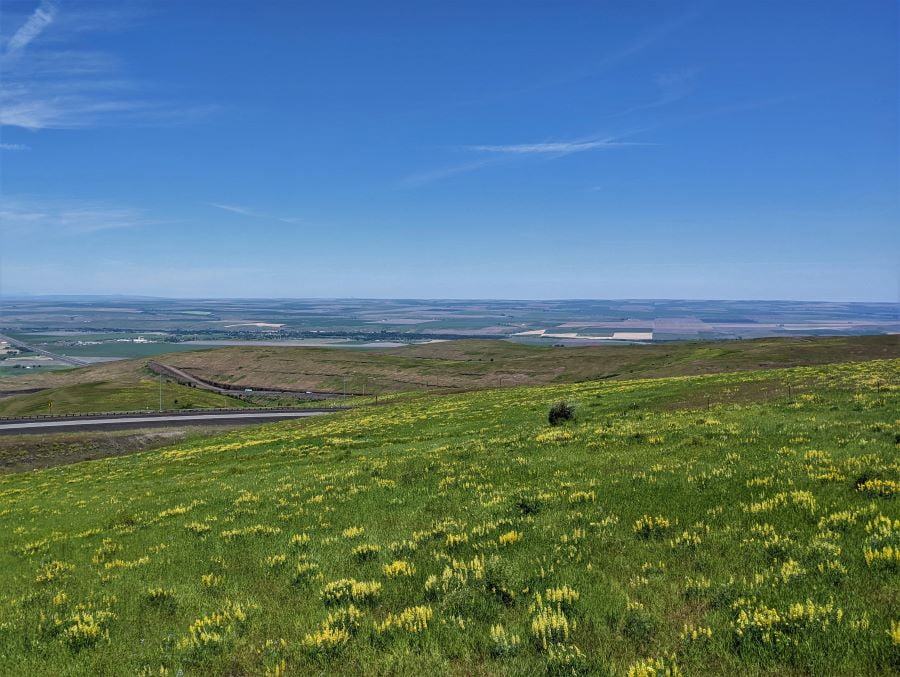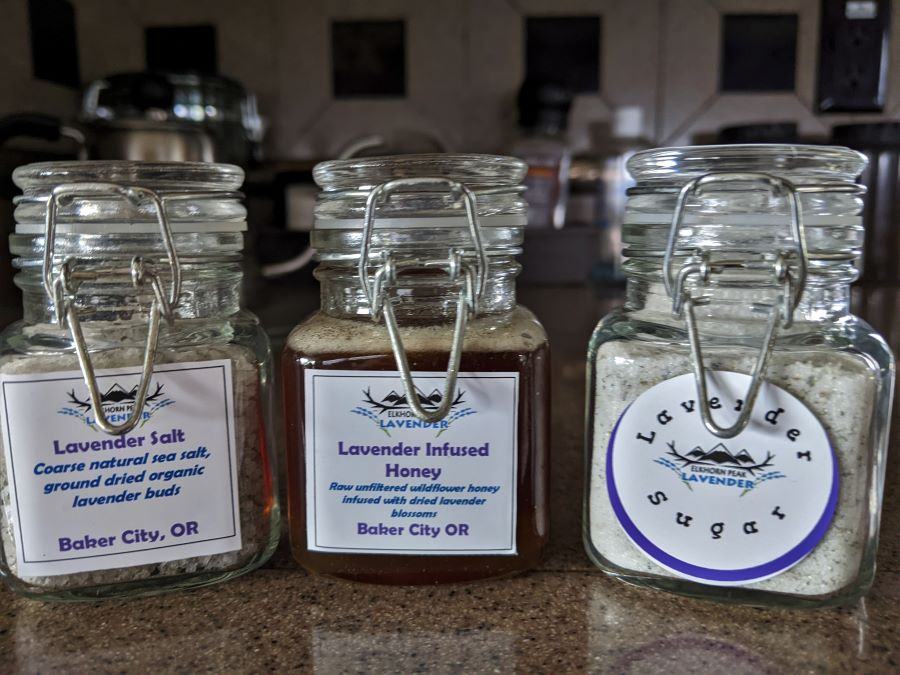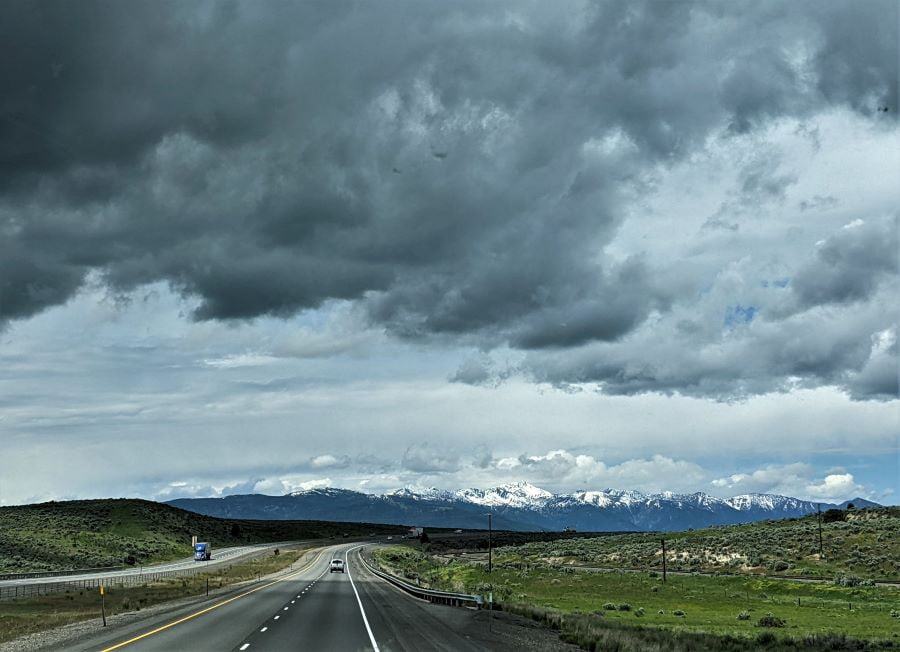For the Oregon Trail Pioneers, crossing the Grande Ronde and the Blue Mountains was near the end of their journey. The Grande Ronde (great round valley) was easy and gentle compared to the last two thousand miles of sage and desert sand. On a wet year, like this spring the Grand Ronde is lush green. The pioneers never saw it like this because they were on the trail all summer. By the time they got here, it was typically September and all the spring growth turned brown. To them, it was just easier than fighting with sagebrush.
Assuming that you don’t count the previous two thousand miles on foot, the Blue Mountains was the most difficult part of the journey. Compared to the steep, densely wooded terrain of the Blue Mountains, the rest of the Oregon Trail is flat. The Oregon Trail tried to avoid mountain crossings. For us, even though it was still (almost) winter, it was a delight.

This spring we left Boise and crossed the northeast corner of Oregon following the Oregon Trail. Overall, we have spent lots of time exploring Oregon during our almost five-year journey. In fact, looking back, I was surprised at how much time we have spent in Oregon. Here is a link to some other stories. Oregon Stories
The Astor Overland Trail
Before being known as the Oregon Trail, this route was used and explored by the Pacific Fur Company. The trail went from Saint Louis all the way to the Pacific Ocean. Only a few years earlier Lewis and Clark explored the northern route to the Pacific Ocean, through Montana. Lewis and Clark went all the way to the mouth of the Columbia River (1804-1807).
In 1810 John Jacob Astor (wealthy New York owner of the American Fur Trading company) decided to try to expand to the west. One objective was to create a wagon road to the west. Later, much of that wagon road was renamed the Oregon Trail.

After crossing the Grande Ronde and the Blue Mountains the Oregon Trail would then follow the Columbia River westbound. In terms of difficulty, the Blue Mountains were the last and biggest obstacle on the entire Oregon Trail. Above all, you didn’t want to cross them in the winter, especially if you are on foot, as was the Astor party, or as a pioneer on the Oregon Trail.
Interstate 84
For us, Interstate 84 made for an easy drive, although the clouds threatened rain the entire way. When we stopped outside of Baker City, at Elkhorn Lavender Farms, the rain started.
The Baker Valley is twenty miles south of Grande Ronde and the Blue Mountains. Baker Valley and Grand Ronde are surrounded by mountains. To the southwest is the Elkhorn mountains to the northeast is the Wallow mountain range. To the north is the Blue Mountains.
Even if you went around the Wallowa Mountains to the east, you still have to cross the Blue Mountains. There are ways that don’t include these mountains across Oregon from east to west. The problem with these routes is a lack of dependable water. We used these different routes in 2018 and 2020 and covered them in these stories. More Cattle than People and Halfway between Boise and Bend Oregon

Elkhorn Peak Lavender
This lavender farm is just outside of Baker City. The “farm” tucked is in against the Elkhorn Mountains. At the farm, they grow, harvest, and then process the lavender to make lavender oil. The Elkhorn Peak Lavender Farm is a host member of Harvest Hosts and we had a great campsite between the Lavender fields and a pasture.
The pasture is the home to a family of “pack” goats. Pack goats are used similar to horses when packing camping gear up into the mountains. They carry lighter loads than horses and most importantly will eat nearly anything meaning other than finding a place to camp with water, they are happy (food-wise) nearly everywhere.

Harvest Host
Staying at a Harvest Host location is so much better than staying at an RV park. Especially compared to our previous RV park in Boise. I have outlined the program before. Typically the host will be on a farm or some location like that and part of the deal is that as a guest on the property you agree to make a purchase. This time, since it was a lavender farm we got some lavender spices.

Emigrant Springs
As we descended the Blue Mountains northbound we stopped at Emigrant Springs. The Oregon Trail Pioneers camped there and so did we. The pioneers camped here because of the spring water. We camped here because it was along the road further north. Emigrant Springs is about ten miles to the east of Pendelton. Pendelton is a very interesting town. Here is a link to a great story about Pendelton. Pendleton, Shirts, Tunnels, and Boarding Houses
Overall we didn’t really like camping at Emigrant Springs. The good part is that it was inexpensive due to my Oregon State Park Special Access pass. I described this in my post about the pass here. Special Access Pass. The bad thing about Emigrant Springs is that it is located only a few feet from Interstate 84.
Destination Washingon
We chose our route across the corner of Oregon and ended it in south-central Washington. After that, we turned back east to get back to Idaho. We could have taken a more northern, more direct, much harder road than Interstate 84. Instead of following the interstate, we could have winded our way north along the Snake River. Overall our route was much easier because travel in the mountains saves miles, but doesn’t save time because the roads are much more difficult.
Please subscribe and join us on our journey
We will add you to our email list and send you updates about once a week. Here is a link. Subscribe


Sounds like all that solar came to good use with the generator down.
We really enjoy the vicarious pleasure we get following along with your travel adventures.
Looking forward to hopefully meeting up with you this fall.
God’s speed and Safe Travels my friends.
I got the generator fully operational this morning. The problem was that I paid to have the radiator flushed back in March.
So after troubleshooting, the problem was that the mechanics didn’t refill the radiator correctly allowing it time to purge the air out of the passages. So we ended up without enough antifreeze.
It was about a quarter of a gallon low of antifreeze. One of the issues is that the overflow tank is yellow and you can’t see the overflow fluid level.
If you want to have something done right, you have to do it yourself.
We are in Scottsbluff/Gering Nebraska now, which is the halfway point on the Oregon Trail. Unfortunately, driving the trail is for some other year.
Enjoy!!!
We really enjoyed our stay in Scotts Bluff and then after that, we went to Fort Robinson. Fort Robinson is especially great. Here is a link to that story.
https://foxrvtravel.com/hidden-gem-in-nebraska/
Here is another entry for the “it’s a small world” book. We were on a trip heading from Arizona to Washington state and we got off the highway at Baker City and spent a couple nights at a Harvest Host – not the same one. This one was a winery. The owner is the great grandson of a pioneer taking his family west in a mule drawn wagon on the Oregon trail. We really enjoyed our stay.
I really liked the valley especially since it was spring and even though we got snow just up the mountain, we only had some rain.
When you get to Portland, take a little trip to the south to McMinnville to visit the Evergreen Aviation Museum. If you haven’t been there it is amazing and the home of the Spruce Goose. We were there a couple of weeks ago to deliver a helicopter from Classic Rotors and pick up an engine in trade. It is a world class aviation museum. Check it out at evergreenmuseum.org . Safe travels. Chip
We have been there and really enjoyed it. They let us camp out behind the museum. It was great to wander around the outdoor exhibits after hours. Here is the link.
https://foxrvtravel.com/mcminnville/